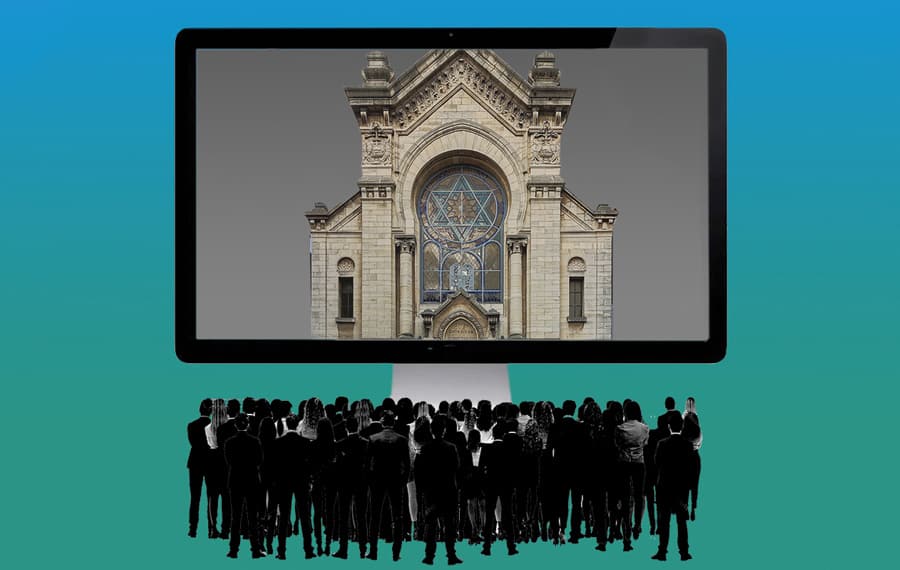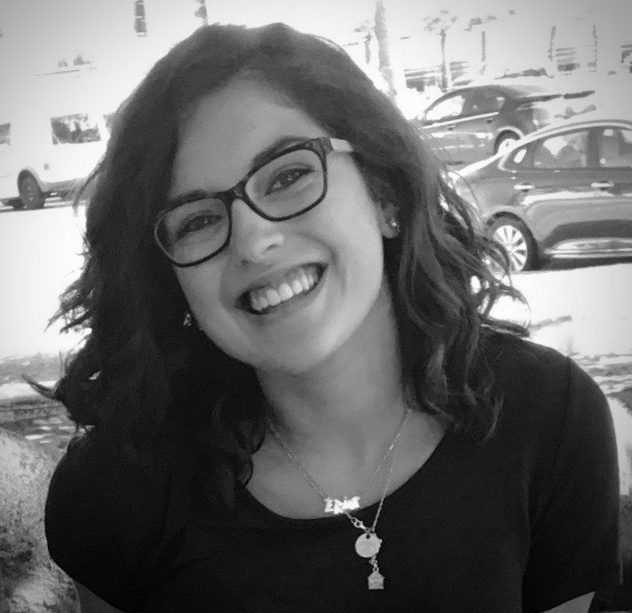
For roughly 2 1/2 months, synagogues have been closed to the community. Some wonder about the fate of the sanctuaries during COVID-19 while their role wanes as the social hubs for Jewish life.
But while the buildings may be empty, according to rabbis and congregants of all denominations who spoke with the Journal, congregations are doing just fine. Clergies are becoming creative and innovative, using technology to connect with their communities during quarantine.
And with the May 14 ruling by the Conservative movement allowing congregations to livestream their services on Shabbat and on holidays during COVID-19, it’s opened up a whole new world for Conservative synagogues. The latest ruling comes on the heels of the decision to allow Conservative congregants to say Mourner’s Kaddish through a virtual minyan.
“What [the] pandemic has forced us and encouraged us and inspired us to do is find new ways to reach out,” Rabbi Steve Leder of Wilshire Boulevard Temple (WBT) told the Journal. “It’s great. It’s been a very invigorating experience for me and all our clergy. More are engaging online, frankly.”
WBT, which has been utilizing live-streaming for more than a decade to connect with congregants, has added Zoom and Facebook Live to engage daily, not just during Shabbat.
Jodi Berman Kustanovich, who belongs to WBT and Valley Beth Shalom (VBS), said she’d go to WBT’s Friday night services maybe once a month. Now she is tuning in online every Friday night. She also tunes in with her husband on Saturdays at VBS for Torah study.
“The services are different every single week,” she said. “[WBT is] experimenting in ways I’ve never seen them experiment before. We are getting much higher attendance because people feel the need for connection and it feels more interesting to me as a person who has gone to synagogue my entire life.”
Rabbi Lori Shapiro at Open Temple said while the situation has been hard on her and her congregation, they are lucky that Open Temple started as “a shul without walls” to think outside the box. Since the outbreak of the coronavirus, virtual attendance and engagement has been high, especially with religious school. “Judaism is more viral than this virus,” Shapiro said. “We’ve endured so much more than a pandemic. Judaism knows how to respond. It’s time to put this into action.”

Because congregants can now tune in to services via their home computers, they no longer need to get dressed up, drive in rush-hour traffic or even be in a single time-zone to participate in a service. Chicago resident Shayna Plankar said she watches virtual services with her mother, who lives in Maryland. From two states, they tune into services in New York so Plankar can watch her former rabbi lead services on Saturday mornings.
“Hearing [the rabbi’s] sermons has been beautiful and attending bar and bat mitzvah services for people we don’t even know have been so joyful,” Plankar said. “I’m on the phone with [my mom] and she’s saying how lovely it is and commenting on how beautiful their dresses [are] and all of a sudden my mom is like, ‘I feel like we are in shul, whispering.’ We continue to log on regularly.”
“Judaism is more viral than this virus. We’ve endured so much more than a pandemic. Judaism knows how to respond. It’s time to put this into action.” — Rabbi Lori Shapiro
Michigan synagogues are seeing similar results because the state’s stay-at-home orders continue to keep congregants sheltered in place.
Rabbis Aaron Starr and Yoni Dahlen said that their shul, Congregation Shaarey Zedek (CSZ) in Southfield Mich., has utilized live-streaming for more than a decade but because congregants no longer are able to be inside the building, the conservative congregation turned to Zoom for two-way communication during programs, especially during services when The Mourner’s Kaddish and Mi Sheberach prayers are said. Starr said this experience has been “eye-opening” because CSZ has been able to be more creative and inclusive.
“In some ways our world is smaller but in other ways our world is larger,” Starr said. “We have lowered barriers to access by having people not only watch our service but participate in our service. They can engage in a much more meaningful way.… I don’t think we are going back. Even when we return to the physical building, we will utilize Zoom. I can envision a reader’s table that has a spot for the Torah scroll, a spot for the prayer book and a spot for the laptop.”
Using the app Acapella, Cantor Neil Michaels of Temple Israel in West Bloomfield, Mich., has been able to record and produce prayers and songs for services using harmonies, instruments and other clergy members’ voices. The temple, which hosted Friday night services with 400-600 people in attendance, now sees dramatically higher numbers because of its ability to incorporate music, prayer and technology in its pre-recorded online services.
“We talked to our children, who are much more tech-savvy, the TikTok generation,” Michaels said. “[Acapella] enables us to collaborate and be able to fuse it all together with an audio mix in a really short period of time for a cohesive service.”
Rabbi Nolan Lebovitz of Adat Shalom in Westwood said he is seeing at least 75 screens for Zoom Shabbat services. He said he believes people will return to synagogue when things are more calm but for now, people are looking for connection from a place of isolation. Online services, he said, offer opportunities for the synagogue to provide “that sense of belonging to people. We are in the process of adapting. Judaism is not changing. What we realize now is that the essential part of Judaism for synagogue life is community. We can’t allow that to dissipate under the current challenges. Especially in this virtual realm.”

Carly Einfeld, who is Modern Orthodox, works at Young Israel of North Beverly Hills and said that while they can’t stream services during holidays or on Shabbat, they are still able to Zoom Kabbalat Shabbat services, which has proven to not only be successful but brought comfort to the small congregation.
“We are finding more people are joining us for Kabbalat Shabbat. We do a Zoom but we also stream it to Facebook so while numbers on Zoom are small, the Facebook views are high,” Einfeld said, adding the shul has been working diligently to help older members connect with technology so they can still be included in ritual life. “Some of our members live alone so I know this is important. It definitely keeps me inspired to work hard to keep those connections going.”
For Beverly Hills pediatrics specialist Nicole Nourmand, who used to attend IKAR when she wasn’t on call, attending virtual services are the few moments a week she has to feel connected. “I need it. It’s so hard to not have IKAR right now,” Nourmand said. “Any sort of connection to the rabbi, the IKAR community, any connection I can have to hear [Cantor] Hillel [Tigay] daven, I’ll take it.”
Rabbi Adam Kligfeld said that Temple Beth Am was timid about going virtual because of its traditional practices, and didn’t want to encourage technology during Shabbat. In September, it added live-streaming in its sanctuary. When COVID-19 hit, Kligfeld said because the congregants already were used to the live-streaming element, it made for an easier transition.
“For every Shabbat service, one clergy member, a rabbi or cantor, goes into the sanctuary and performs the service from beginning to end. People are logging onto the livestream and we are getting hundreds watching. I feel heartened by that. For the rest of the week, we are using Zoom for minyan.”
At Sinai Temple, Rabbi Erez Sherman said that live-streaming was also new to the temple until the pandemic. Mixing Youtube and Facebook Live, Sherman said 1,000 to 1,500 people watch a service after it has been posted, while a few hundred watch live. During its virtual morning minyan, 10 to 50 people pop up on Zoom. They also have been dedicating certain services to nurses, graduating seniors and mothers on Mother’s Day.
“A congregant actually said last week to me, ‘The people that might feel the most uncomfortable are the people that usually come’ because that’s been uprooted [for them]. On the other hand, the people who are comfortable are the people who are not usually attending and they are connecting more than they ever have,” Sherman said. “We have to do both. The worry in the past has been ‘If you put it on TV nobody will come.’ My theory is different. If you put it on TV, the people who would not come before might actually come after.”























 More news and opinions than at a Shabbat dinner, right in your inbox.
More news and opinions than at a Shabbat dinner, right in your inbox.